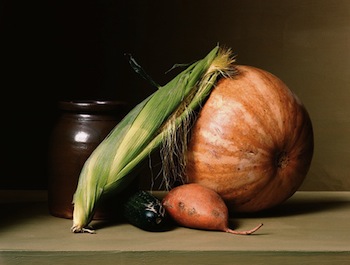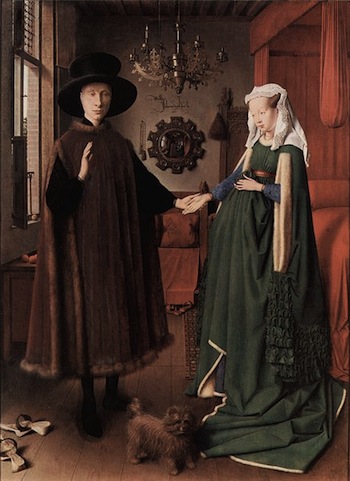
Sharon Core, "Early American, Still Life with Vegetables," 2008. C-print, 16-1/2 x 22-1/4 in. Courtesy the artist and Yancey Richardson Gallery. ©Sharon Core
Gastro-Vision launched last August with a two-part post about the trend in urban farming. Interest in sustainable and local food practices continues to spread among creative types and appears to be gaining momentum. More and more, artists are learning hands-on farming techniques and cultivating their own crops, while artspaces are starting to play host to farmers markets, composting workshops, gardening roundtables, and food residencies. The latest development: an auction of heirloom vegetables to be held at Sotheby’s New York in September.
The Art of Farming is advertised as the first event of its kind “to celebrate edible heirlooms and the art involved in their creation.” An afternoon program of gallery talks on art and food will precede an evening sale of rarities like Turkish Orange Eggplant, Pink Banana Pumpkin, and Lady Godiva Squash, all grown by farmers from the Tri-State area. This all sounds like a good idea, but the asking price of $1,000 per crate? Not so much.
The art world is known for being inaccessible and in this field, outrageous prices are par for the course. (It was Sotheby’s that recently sold the world’s most expensive Warhol portrait at $32.6 million.) Food, however, is a basic human necessity that every living person should have access to. When 49 million people in the United States alone are food insecure, meaning they are unable to afford all the food they need for an active and healthy life, it seems awfully dangerous to associate high art price tags with vegetables, no matter how uncommon they are.
Advocates of sustainable food are often criticized for being elitist, backing policies that could increase food prices, and promoting trendy foods like heirloom tomatoes that, at an average of $4 per pound, are beyond the budgets of many American consumers. If the so-called movement for sustainable, or “good” food wishes to dismantle the idea that eating local is a luxury (as I gather they do), the Sotheby’s event is not helping their case. In fact, it sends the opposite message to the broader public.
To be fair, The Art of Farming is a benefit and intended for a monied audience. It’s also, according to Riddhi Shah of Salon.com, “an event that has its heart in the right place.” The proceeds will aid two reputable sustainable agriculture organizations, and local farmers will have a well-deserved moment in the spotlight of appreciation. “Unfortunately,” Shah continues, “it’s the kind of event that furthers the notion that eating well is an exclusive preserve of the rich.” We can look at the history of art to see that picturing affluence with unusual foods is nothing new.

Jan van Eyck, "Portrait of Giovanni Arnolfini and his Wife" (The Arnolfini Portrait), 1434. Oil on oak, 32.4 in × 23.6 in. Collection of The National Gallery, London.
Early still life paintings by artists such as Raphaelle Peale (who contemporary artist Sharon Core mimics in her photographic series, Early American) were as much about aesthetics as they were records of a patron’s social status and material wealth. Foods and objects from faraway places reveal trade networks and tell of a family’s prosperity. In Jan van Eyck’s 15th century painting The Arnolfini Portrait, four oranges, then exotic and prohibitively expensive, are depicted in the windowsill to signify the couple’s wealth. Fast forward to today and it’s surely more than coincidence that the television series Top Chef and Work of Art air back-to-back on Bravo. There is something to be said for how and with whom the two shows correspond.
Heirloom vegetable are not great works of art, but the creative process, I’ll admit, at least deserves greater recognition. In short, heirlooms are cultivated plants that have been selected for pleasing characteristics such as color, form, and flavor. They are able to maintain their original traits by way of open pollination (by insects, birds, wind, etc.) for no less than 50 years. Heirloom seeds, as their name suggests, are typically passed down through several generations of a family. “An [heirloom] tomato on an art auction block is not just a commodity to be consumed,” says Alida Cantor of the organization Chefs Collaborative, “it is a representation of a long history of craftsmanship and careful work.” Few could deny that there is value in that. But even Cantor, who is fully aware of an heirloom’s worth, questions whether The Art of Farming perpetuates the image of sustainable food as elitist and out-of-reach. To try and argue that it doesn’t would be a harder sell than a $1,000 crate of vegetables.




Pingback: ACMP
Pingback: Food on Her Mind :: raiding the larder
Pingback: Food on Her Mind :: raiding the larder